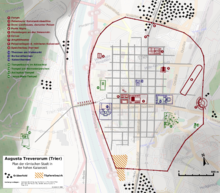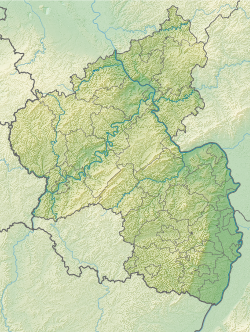Barbara Baths
This article relies largely or entirely on a single source. (February 2014) |
| UNESCO World Heritage Site | |
|---|---|
 Trier Barbarathermen | |
| Location | Trier, Rhineland-Palatinate, Germany |
| Part of | Roman Monuments, Cathedral of St Peter and Church of Our Lady in Trier |
| Criteria | Cultural: (i), (iii), (iv), (vi) |
| Reference | 367-003 |
| Inscription | 1986 (10th Session) |
| Coordinates | 49°45′00″N 6°37′49″E / 49.75°N 6.630278°E / 49.75; 6.630278 |
The Barbara Baths (German: Barbarathermen) are a large Roman bath complex in Augusta Treverorum, modern-day Trier, Germany. Stretching over 42,000 square meters, it is the largest Roman bath north of the Alps.[1] Along with other sites in Trier, the bath complex was designated a UNESCO World Heritage Site in 1986 as part of the Roman Monuments, Cathedral of St. Peter and Church of Our Lady in Trier site, because of its historical importance and sprawling architecture.[2]
History


Roman Period
The Barbara Baths were built in the second half of the 2nd century C.E. along with a burst of building activity including a new bridge, an amphitheater and large forum.[3][4] The Barbara Baths were built to meet the growing need for bathing in Trier when the Forum Baths became too small, the Barbara Baths, when completed, would measure 172 m x 240 m and encompass two city blocks.[4] Their size would also increase demand for water, which would be supplied from the Ruwer aqueduct.[5] This burst of activity appears to be a part of displays of wealth fitting the seat of the Roman Procurator of Gallia Belgica Germania Inferior and Germania Superior.[6] The bathing rooms and swimming pool was modeled after baths from North Africa.[7] The heated rooms of the bathhouse are notable for using a two-story hypocaust.[8] A marble torso of an Amazon warrior, now in the Landesmuseum Mainz, indicates that the bath complex would have been elaborately decorated with imported statues from Italy.[9] It remained in use through the end of the fourth century.[1][9] But the complex fell out of use during the early fifth century as Trier was repeatedly sacked during the Migration Period.[10]
Later usage
The extensive ruins were used as for many things following the collapse of the Western Roman Empire. As early as the 5th century C.E. there are recognizable remains of residential buildings, the beginnings of the suburb of St. Barbara. Early Christian grave inscriptions demonstrate a possible Merovingian period church. Later in the Middle ages fortifications were installed in the ruins as seen in Matthäus Merian and Alexandre Wiltheim's drawings. Stating in 1611 C.E. the remains were recycled as building material for constructing a Jesuit College, which was later destroyed.[4]
Current Remains
Only the foundations and the subterranean service tunnels have survived, but the technical details of the sewer systems, the furnaces, the pools, and the heating system can be studied better than in the other two baths of Trier.[9] The site is open to visitors and the remains can be viewed from a footbridge, with waysides along the bridge to help visitors.[11]
Gallery
-
Model of Augusta Treverorum showing location of Barbarathermen Trier ca. 360–370 AD
-
ca 1548 from an engraving by Matthäus Merian published 1646
-
Ruins of Barbara Baths by Alexandre Wiltheim, c. 1620
-
Ruins of Barbara Baths by Alexandre Wiltheim, c. 1620
-
Ruins of Barbara Baths by Alexandre Wiltheim, c. 1620
-
Ruins of Barbara Baths by Alexandre Wiltheim, c. 1620
-
Conservation and restoration of the Roman ruins (1990)
-
Conservation and restoration of the Roman ruins (1990)
-
Barbara Baths Today
-
Sleeping Cupid in Rheinisches Landesmuseum Trier
See also
References
- ^ a b "Tourist-Information Trier". www.trier-info.de. Retrieved 22 May 2022.
- ^ "Roman Monuments, Cathedral of St Peter and Church of Our Lady in Trier". UNESCO World Heritage Centre. United Nations Educational, Scientific, and Cultural Organization. Retrieved 22 May 2022.
- ^ Sear, Frank (1982). Roman Architecture. Ithaca, NY: Cornell University Press. p. 228. ISBN 0-8014-9245-9.
- ^ a b c Goethert, Klaus-Peter (2003). Römerbauten in Trier. Regensburg: Schnell & Steiner. pp. 76–105. ISBN 3-7954-1445-8.
- ^ Kuhen, Hans-Peter (2001). Das Römische Trier. Verlag Theiss. ISBN 3806215170.
- ^ Wightman, Edith Mary (1971). Roman Trier and the Treveri. New York: Praeger Publishers. pp. 82–85.
- ^ "Barbarathermen". Rheinisches Landesmuseum. Rheinisches Landesmuseum. Retrieved 19 January 2023.
- ^ Yegul, Fikret (2010). Bathing in the Roman World. Cambridge: Cambridge University Press. p. 83. ISBN 978-0-521-54962-2.
- ^ a b c Gwatkin Jr., William E. (1933). "Roman Trier". The Classical Journal. 29 (1): 6.
- ^ "Explore the excavation of Roman Baths". Visit World Heritage. Retrieved 20 January 2023.
- ^ "THE BARBARA BATHS". Trier Tourism and Marketing. Retrieved 21 January 2023.
External links
- "Tourist-Information Trier: Barbara Baths: Info". trier-info.de. Retrieved 2014-01-31.
- "Trier, Baths of Barbara Info". Livius.org. Retrieved 2023-01-22.



.jpg/440px-Barbarathermen_Trier_Merian_1646(1548).jpg)






